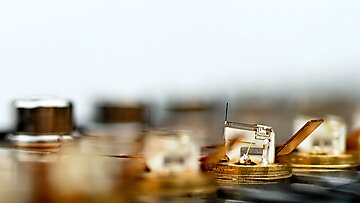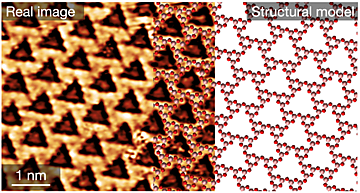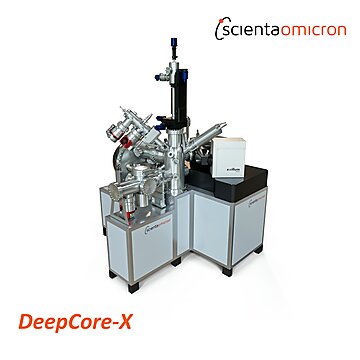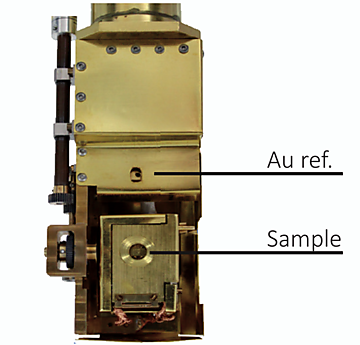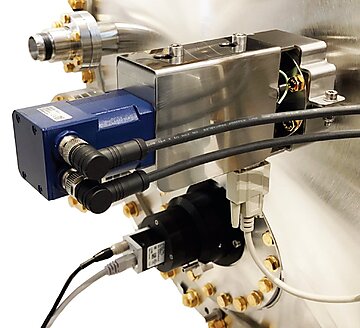Accelerating Materials Innovation
Result of the Month (ROM), January 2026
Two-dimensional diboron trioxide crystal composed by boroxol groups
Diboron trioxide (B2O3) represents an unusual case among polymorphic oxides, because its vitrified state features superstructural units — planar boroxol groups— that are never observed in its three-dimensional crystalline polymorphs. Crystalline polymorphs that incorporate boroxol groups have only been predicted theoretically, although their formation is crucial to rationalize the ability of B2O3 to vitrify. Here we present the synthesis of a two-dimensional crystalline B2O3 polymorph constituted by boroxol groups arranged in an atomically thin honeycomb lattice. By combining surface science experimental techniques with ab initio calculations, we characterize the structural and electronic properties of this B2O3 polymorph down to the atomic level. This discovery enlarges the family of two-dimensional materials and enables the atomic tracking of individual structural units in trioxides.
Latest news
Introducing DeepCore-X
Designed for advanced surface and bulk materials research, DeepCore-X enables high-resolution X-ray Photoelectron Spectroscopy (XPS) and Hard X-ray Photoelectron Spectroscopy (HAXPES) in a single, laboratory-based instrument. With its high-flux Ga Kα MetalJet F-series source (9.25 keV) and the synchrotron-proven EW4000 analyser, DeepCore-X delivers synchrotron-like performance while maintaining ease of use in a compact system. Automation of sample handling, smart workflows, and camera-assisted navigation make DeepCore-X a highly productive and accessible platform for every level of expertise.
Sample Manipulators
Open and Closed Cycle Sample Manipulators
When aiming at high experimental energy resolution for ARPES measurement, it is crucial to achieve ultra-low sample temperatures to quench thermal broadening. This is possible with state-of-the-art cryo manipulators reaching sample temperatures from < 3.5 K and featuring up to 6 fully motorized axes for a large range of movements. The manipulators are available as open and closed cycle. Open cycle manipulators reach lower temperature specifications and are rapidly cooled down from room temperature to 10 K in 15 min. The low He consumption below 1 l/h at ultimate temperature and the possibility to operate with liquid nitrogen at higher temperatures ensure a low operating cost. Closed cycle manipulators have no He consumption providing unlimited holding time.
Service Upgrade
PEAK Slit Control
Optimal analyser settings with remote control
In photoelectron spectroscopy measurements, there is always a trade-off between signal intensity and resolution. Optimising this balance is the key to obtaining smooth and sharp spectra within the shortest time possible. For hemispherical analysers, this trade-off is controlled by the selected entrance slit and pass energy.
PEAK Slit Control replaces manual slit changes at the analyser with a motorised and software-controlled slit. With the control of all analyser settings, easy and quick optimisation of signal intensity versus resolution is possible.
About Us
Scienta Omicron is a leading innovator in Surface Science and Nanotechnology. At our technology centres in Uppsala, Sweden and Taunusstein, Germany we develop and produce high-tech instruments. Our instruments support top researchers globally and are serviced by our four regional hubs in USA, China, Japan and Germany.
We provide state of the art instruments in Electron Spectroscopy, Scanning Probe Microscopy and Thin Film Deposition. Focusing on the race for new unique materials and solutions, in areas like – smarter batteries, next generation electronics, quantum technologies, solar energy, intelligent sensors and advanced materials, Scienta Omicron enables development of tomorrow´s materials.
THE SCIENTA GROUP: One Group, Two Leading Brands
Since 1983 the combined companies, including Scienta Omicron and Scienta Envinet (former Scienta Sensor Systems and Envinet GmbH respectively) that make up the Scienta Scientific Group have been leading the development of ultra high vacuum research and analysis equipment in the fields of Surface Science, Material Physics, UHV technology and Radiation Detection, resulting in scientific breakthroughs, Nobel Prizes and outstanding industrial equipment.


